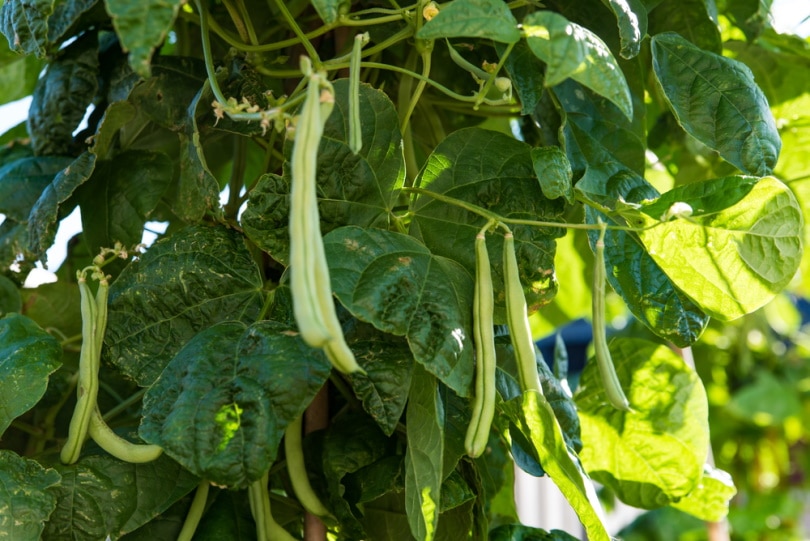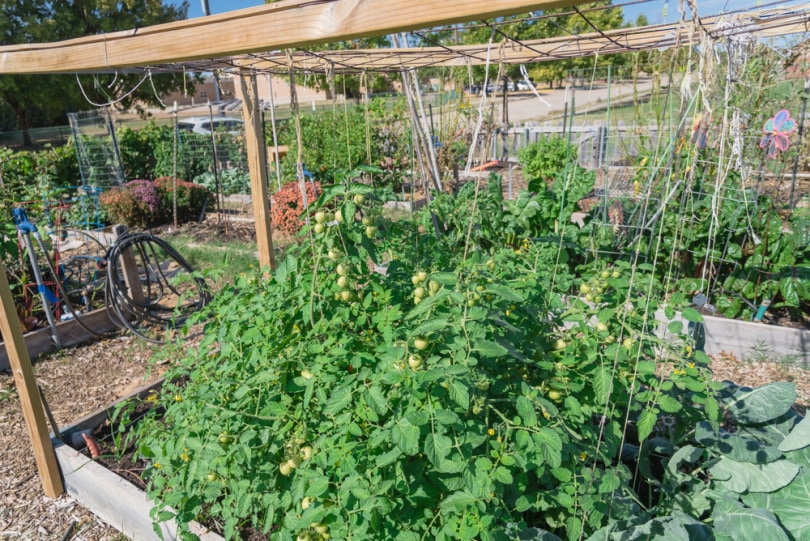10 Companion Plants for Rosemary (With Pictures)
-
Jana Blagojevic
- Last updated:

Rosemary is a lovely shrub-like herb that grows stunning evergreen fragrant foliage. The leaves have a characteristic narrow blade-like shape and a strong aroma. The leaves are frequently used fresh or dry and are one of the favorite herbs for cooking many dishes worldwide.
Rosemary grows better with some nearby companion herbs and can also benefit from certain companion fruits and vegetables. To learn which plants can be excellent companions to rosemary and which plants to avoid, read on below.
The 10 Companion Plants for Rosemary
1. Carrots

| Botanical name | Daucus carota |
| Soil type | Well-drained, loose, fertile soil |
| Sun requirements | Full sunlight |
Carrots are a vegetable that often deals with a particular pest called carrot flies. These flies lay eggs around the soil of carrots, and once the eggs hatch into larvae, they begin feeding on the outer layer of the carrots’ roots. Given that carrot flies are attracted to the smell of carrots, planting rosemary nearby can be a true hero for these plants.
The rosemary bush will distract the flies, masking the smell of carrots. Since rosemary has such a strong and lovely fragrance, it will be a beautiful addition paired with carrots.
2. Cauliflower

| Botanical name | Brassica oleracea var. botrytis |
| Soil type | Rich and fertile soil, moist but well-drained |
| Sun requirements | At least 6 hours of direct sunlight daily |
Rosemary is the best companion plant for cauliflower you can plant. Since rosemary can be grown into an evergreen hedge, it will be a perfect pair with cauliflower. Like other varieties in the Brassica family, cauliflower can benefit highly from having rosemary around. The strong and spicy aroma of rosemary will confuse pests that tend to attack cauliflower, like cabbage worms. This fragrant herb will help keep the pests away and the cauliflowers in your garden safe.
3. Cabbage

| Botanical name | Brassica oleracea var. capitata |
| Soil type | Loamy soil, well-drained and moisture-retentive, rich in organic matter |
| Sun requirements | At least 6 hours of direct sunlight daily |
Cabbage, like cauliflower, is another Brassica variety that can significantly benefit from rosemary and vice versa. The cabbage moth can be devastating to cabbage, destroying the health of the entire crop. The scent of rosemary can significantly aid in the healthy growth of cabbage. While cabbage can never be truly pest-free, rosemary can play an essential role in reducing pest infestations.
4. Beans

| Botanical name | Phaseolus vulgaris |
| Soil type | Loamy, warm, well-drained soil |
| Sun requirements | Full sun |
Beans are another vegetable that is frequently prone to pest attacks. Mexican beetles are a common problem for beans, but the intense fragrance of rosemary can help drive them away. Planting rosemary near beans can reduce the risk of attracting the Mexican bean beetle. Planting rosemary and beans together will bring both plants certain benefits, and while you can’t eliminate pests, you can significantly reduce their number.
5. Strawberries

| Botanical name | Fragaria ananassa |
| Soil type | Well-drained, rich, and slightly acidic soil |
| Sun requirements | Full sun, or partial shade |
Rosemary and strawberries are plants that grow exceptionally well when paired together and can bring outstanding results. These two are great companion plants and planting them nearby will improve their fertility. When strawberries have a companion plant, their quality and flavor improve. Strawberries often deal with unwanted pests, but planting rosemary can repel insects that may want to attack your plant.
6. Marigolds

| Botanical name | Tagetes |
| Soil type | Loamy, fertile, well-drained soil |
| Sun requirements | Full sun or partial shade |
Rosemary and marigolds go great together, primarily because of their unique colors that can together create a charming and showy garden. With the deep green foliage of rosemary and the orange to mahogany colors of marigolds, your garden will pop with colors. Many plants love having marigolds nearby as companion plants, with rosemary being one of them.
Both marigolds and rosemary are excellent at repelling unwanted pests, while marigolds are also pollinator-friendly, attracting beneficial insects to your garden.
7. Lavender

| Botanical name | Lavandula |
| Soil type | Fast-draining, dry soil |
| Sun requirements | 6 to 8 hours of daily sun exposure |
Rosemary and lavender are two plants that enjoy the same growing conditions, making them excellent companions. Both plants enjoy a lot of natural sunlight during the day and soil with excellent draining properties. Another benefit of adding lavender to your garden near rosemary is that this plant will attract many pollinators.
One thing to look out for is that lavender is much more tolerant of colder climates than rosemary.
8. Oregano

| Botanical name | Origanum vulgare |
| Soil type | Well-drained soil, neutral to slightly acidic |
| Sun requirements | Full sun, at least 6 hours of exposure daily |
Rosemary and oregano are both herbs that enjoy growing in the same conditions. These plants belong to the mint family, characterized by aromatic and fragrant foliage. Providing these plants with direct sunlight and well-drained soil will give you excellent results. Planting oregano in your garden will result in a stunning green carpet spreading across the garden bed. These two plants are best paired with a third companion plant that can tolerate cold weather.
9. Sage

| Botanical name | Salvia officinalis |
| Soil type | Fertile, moist, and well-drained soil |
| Sun requirements | Partial shade and full sunlight |
Sage is another fragrant herb that is a lovely addition to any garden bed. With its soft aroma and many health benefits, sage is an excellent herb to grow. Planting rosemary and sage as companion plants can remarkably affect both plants. Rosemary can boost the health of sage and improve its flavor. It is best to plant these two herbs in a location with plenty of natural sunlight but they will also tolerate partial shade.
10. Thyme

| Botanical name | Thymus vulgaris |
| Soil type | Loamy, sandy, well-drained soil |
| Sun requirements | Plenty of natural, direct sunlight |
Rosemary is a lovely herb that can be paired with almost any other companion herb to create an aromatic garden bed. One herb that brings many benefits to rosemary when planted nearby is thyme. Thyme gives more benefits to rosemary than it receives. It helps rosemary fight off any unwanted pests, while it flourishes better with rosemary by its side.
These two fragrant herbs enjoy growing in the same conditions, which are sandy or loamy soil with excellent draining properties and plenty of sunlight.
The 5 Worst Companion Plants for Rosemary
1. Mint

Mint may be one of the worst companion plants for rosemary, primarily because of the different preferences in growing conditions. While rosemary requires dry and well-draining soil, mint thrives in damp soil. Another risk when planting these two herbs together is creating a competitive environment. At the same time, mint tends to overpower any nearby plant, taking over a lot of space, while rosemary can grow up to 4 feet tall.
2. Pumpkin

While rosemary has pest-repellant qualities, planting it next to any type of pumpkin can seriously harm and damage the plant. Pumpkins are prone to mildew infestations, so planting them near rosemary can lead to root rot or powdery mildew developing on the plant.
3. Cucumbers

Cucumbers are never great companions for herbs or aromatic plants. Since cucumbers use up a lot more water and must be watered more frequently than rosemary, the herb would drown. Another factor that can affect rosemary negatively is the high nitrogen content in the soil, which cucumbers thrive with.
4. Tomatoes

Rosemary is always best kept apart from tomatoes because tomatoes need a lot of water to thrive and love certain conditions which rosemary can’t handle. Rosemary is also a harmful companion plant for tomatoes because it can take up all the beneficial nutrients from the soil needed for a tomato’s healthy growth.
5. Basil

While both basil and rosemary are herbs with similar growing requirements, unlike rosemary, basil thrives in damp soil. Since neither plant can benefit from having the other as a companion, it is unnecessary to plant them nearby. You can only damage your rosemary plant by providing it with too much water to please your basil plant.
In Conclusion
Rosemary is a magnificent and valuable plant that each garden lover needs in their collection. Once this plant establishes itself, it becomes self-sustaining. It thrives in dry, fast-draining soil, with plenty of light provided. Many plants enjoy the same conditions as rosemary, which can be excellent companion plants. After reading this helpful list of the best and worst companions for rosemary, you will create an organized and thriving garden field with healthy and fragrant herbs.
- Rosemary Companion Planting: 5 Plants to Pair With Rosemary – 2022 – MasterClass
- 10 Rosemary Companion Plants (& 5 Plants To Keep Far Away) – Blooming Backyard
- 13 Rosemary Companion Plants (What Not To Grow Near Rosemary) | TheHomeTome
- Rosemary Companion Plants: 15 Best Plants to Grow With Rosemary | UnAssaggio
Featured Image Credit: pilialoha, Shutterstock
Contents
